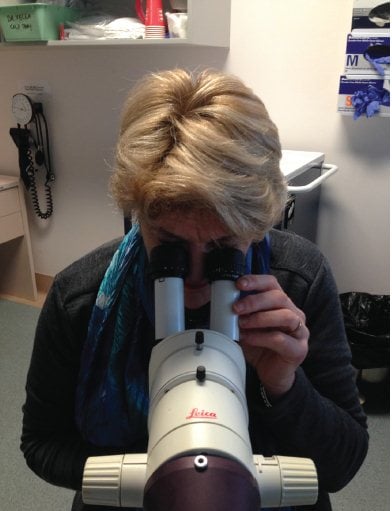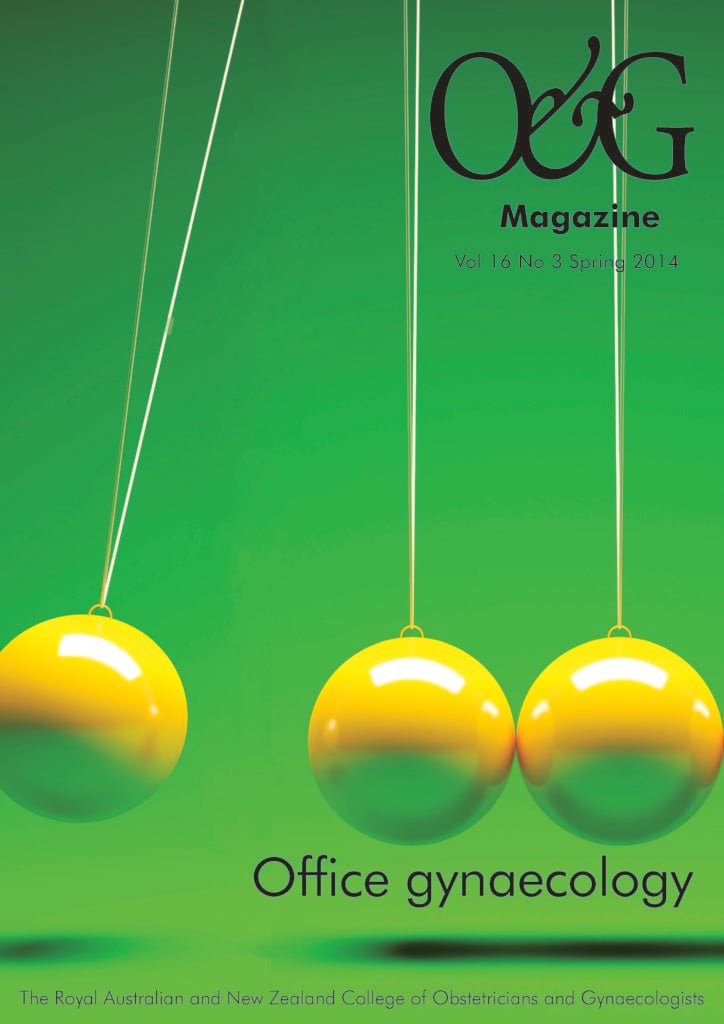Colposcopy itself is currently in a zone of transformation, with new technology and the Renewed National Cervical Screening Program both affecting practice.
Colposcopy is the visualisation of the cervix and vagina using a binocular microscope together with a bright light source and magnification. The purpose is to locate the transformation zone (TZ), characterise the type of TZ (1, 2 or 3), determine whether normal or abnormal and predict the grade of abnormality. It involves the subjective interpretation of pattern recognition that uses features such as size of TZ, vascular patterns, the type of acetowhitening, borders and iodine uptake. Colposcopy is used to direct both biopsies and treatment.
Indications for colposcopy
Currently colposcopy is needed in the following four situations:
- for evaluation of a woman with a screen-detected abnormality;
- follow up of woman (treated or untreated) with a screen-detected abnormality;
- assessment of a woman with postcoital or other abnormal bleeding; and
- women who have been exposed to diethylstilbestrol (DES) in utero.
The indications for colposcopy referral as a result of a screen-detected abnormality are comprehensively documented in the NH&MRC Guidelines published in 2006.1
Numbers of colposcopy procedures
Colposcopy is the most frequent office procedure in gynaecology. Following the introduction of the NH&MRC guidelines, in 2006, the number of colposcopies (MBS item 35614) fell from nearly 89 000 such items billed to Medicare in 2006–07 to a nadir of under 78 500 in 2010–11. It has slowly risen to nearly 83 000 in 2012–13.2 These numbers do not include the colposcopy examinations that are not billed to Medicare, such as those done in public hospitals. However, these numbers do reflect trends in practice.
The introduction of the Renewed National Cervical Screening Program (NCSP) is predicted to see a rise of approximately 25 per cent in colposcopic examinations. Under the renewed program, women will be referred for colposcopy if they screen positive for HPV 16 or 18, irrespective of cytology, or as a result of abnormal cytology after a positive screen for one of the other high-risk HPV types, with the same cytological criteria as in current NHMRC guidelines.3
Colposcopy and anxiety
The current NCSP has resulted in Australia having one of the lowest incidence rates of cervical cancer in the world and the lowest mortality. This is an enviable record. However, each stage of the screening program is associated with anxiety for women.4 Many studies have investigated the anxiety level of women on receipt of an abnormal Pap smear while awaiting colposcopy. They demonstrate that the level of anxiety is not related to the degree of cervical abnormality and strategies to diminish this anxiety have been evaluated. Minimising the waiting time for colposcopy will reduce anxiety. Colposcopy providers tend to triage patients with wait times related to the degree of abnormality. This may be difficult for those women with cytology results not deemed urgent.
Since 2006, Australian women with a single low-grade squamous cytology report have been recommended to have repeat cytology in 12 months. The Tombola study group looked at the psychological impact of different strategies of immediate colposcopy versus repeat cytology. It showed no clear difference in anxiety and depression between the two arms. Immediate colposcopy detected more HSIL at baseline, but little difference in the cumulative incidence by three years.5
The actual colposcopy procedure itself is a source of great concern to many women. A Cochrane review has reported on strategies for reducing anxiety during colposcopy.6 It would be expected that providing information about colposcopy would reduce anxiety in women waiting for such an examination. However, studies have not confirmed this. Nevertheless, receiving such information is valued by women. An Australian study identified the highest needs while waiting for colposcopy were for information about risks of cancer, reasons for needing a colposcopy and the colposcopy procedure.7 A study from Hong Kong showed that listening to music during colposcopy was associated with a significant reduction in anxiety levels and pain compared to not listening to music.8 This is a simple intervention and can be very low cost if women are asked to bring their own music.

The author in action
Nursing assistance at colposcopy
I believe that one of the most important factors in providing a good colposcopy service is to have an interested and trained colposcopy nurse. This may prove to be an expensive adjunct in private practice, but a good assistant carries many benefits. The nurse can reassure the woman, make sure she is comfortably positioned on the bed, distract her with conversation and provide the colposcopist the assistance required to make the procedure as quick and efficient as possible. Fumbling around on your own, reaching for biopsy forceps and the formalin jar is possible, but not very elegant. During the examination it is not possible for the colposcopist to be fully aware of a woman‘s reaction to the procedure, but your nurse can.
Quality assurance and practice improvement
Another crucial part of good colposcopy practice is keeping abreast of current thinking and practice in colposcopy, which is a moving feast. Attending educational courses is a good way to update practice and is mandated in other countries in order to continue to practise colposcopy. Also having some kind of quality assurance built into your practice has always been desirable and will become mandatory under the Renewed NCSP. The other components of the screening program, in other words cytology and histology, have always been subject to strict quality assurance requirements. On the College website (www.ranzcog.edu.au) you can find the C-QuIP portal that enables you to easily log your colposcopic examinations and findings through a program provided by Solutions Plus.
Documentation and image capture
Documentation is essential and traditionally colposcopists have recorded their findings by a line drawing showing the topography of the TZ, its upper and lower extent and the site of any biopsies. This type of record is increasingly being replaced by image capture, this has many benefits, including:
- very accurate documentation;
- education and training;
- image comparison in follow up of lesions; and
- use in multidisciplinary team discussions.
Image capture is advantageous, but storage, labelling, privacy and consent issues must be addressed.
Scoring systems
One development that has resulted from image capture is the use of tools to improve colposcopic diagnosis. It is known that colposcopy is a subjective skill, has low specificity and sensitivity and low levels of intraobserver and interobserver concordance. Dynamic spectral imaging (DSI) has shown promising results in initial studies. It produces a user-independent quantitative measurement and mapping of the effects of acetic acid.9
Other ways to improve the sensitivity of colposcopic diagnosis has been the development of scoring systems. The Reid score has been around for many years and more recently has seen the development of the Swede scoring system, which recognises the importance of size of the TZ.10 However, it is clear that the more biopsies that are taken at colposcopy improves the diagnostic rate of HSIL. A study from the USA showed, across various levels of training, the number of colposcopically directed biopsies taken is most strongly associated with sensitivity.11
Conclusion
The Renewal of the NCSP will bring major changes to the screening program in Australia. Initially, it is expected that there will be an increase in colposcopy numbers. This will prove challenging in the provision of sufficient services. It is important that we ensure Australian women are receiving excellence in their colposcopy services and all colposcopists are adequately trained. Awareness of the natural history of HPV-related cervico-vaginal disease, the latest concepts in management and treatment and new developments in improving accuracy of colposcopy, must be essential knowledge for all these practitioners.
References
-
- NH&MRC Guidelines 2005 www.nhmrc.gov.au/publications .
- Medicare data www.medicareaustralia.gov.au/statistics/mbs_item. shtml .
- MSAC. National Cervical Screening Program Renewal. www.msac.gov.au/internet/msac/publishing.nsf/Content/1276 2014 .
- Rogstat K E .The psychological impact of abnormal cytology and colposcopy. BJOG 2002; 109: 364-368.
- Sharp L et al. TOMBOLA Group. BMJ. 2009.
- Galaal K et al. Interventions for reducing anxiety in women undergoing colposcopy. Cochrane Database 2011; 12.
- Boneski B et al. Women’s experiences of having a colposcopic examination: self reported satisfaction with care, perceived needs and consequences. J Obstet Gynaecol 1998; 18: 462-470.
- Chan Y M et al. The use of music to reduce anxiety for patients undergoing colposcopy: a randomised trial. Gynecol Oncol 2003; 91: 213-217.
- Soutter W et al. Dynamic Spectral Imaging: Improving Colposcopy. Clin Cancer Res 2009; 15 (5): 1814-1820.
- Bowring J, Strander B et al. The Swede score: evaluation of a scoring system designed to improve the predictive value of colposcopy. J Low Genit Dis 2010. 14(4): 301-305.
- Gage J C et al. Number of Cervical Biopsies and Sensitivity of Colposcopy. Obstet Gynec 2006; 108 (2): 264-272.






Leave a Reply